 W
WA quasar is an extremely luminous active galactic nucleus (AGN), in which a supermassive black hole with mass ranging from millions to billions of times the mass of the Sun is surrounded by a gaseous accretion disk. As gas in the disk falls towards the black hole, energy is released in the form of electromagnetic radiation, which can be observed across the electromagnetic spectrum. The power radiated by quasars is enormous; the most powerful quasars have luminosities thousands of times greater than a galaxy such as the Milky Way. Usually, quasars are categorized as a subclass of the more general category of AGN. The redshifts of quasars are of cosmological origin.
 W
WA hot, dust-obscured galaxy, or hot DOG, is a rare type of quasar. The central black hole of such a galaxy emits vast amounts of radiation which heats the infalling dust and gas, releasing infrared light at a rate about 1,000 times as much as the Milky Way, making these some of the most luminous galaxies in the universe. However, the density of the surrounding dust is so great that most of that light is obscured. Their average temperatures range from 60 to 120 K, significantly higher than an average galaxy's temperature of 30 to 40 K. They also appear to concentrate a much higher proportion of their galactic mass in the central black hole than is observed in normal galaxies.
 W
WA quasar is an extremely luminous active galactic nucleus (AGN), in which a supermassive black hole with mass ranging from millions to billions of times the mass of the Sun is surrounded by a gaseous accretion disk. As gas in the disk falls towards the black hole, energy is released in the form of electromagnetic radiation, which can be observed across the electromagnetic spectrum. The power radiated by quasars is enormous; the most powerful quasars have luminosities thousands of times greater than a galaxy such as the Milky Way. Usually, quasars are categorized as a subclass of the more general category of AGN. The redshifts of quasars are of cosmological origin.
 W
WA quasar is an extremely luminous active galactic nucleus (AGN), in which a supermassive black hole with mass ranging from millions to billions of times the mass of the Sun is surrounded by a gaseous accretion disk. As gas in the disk falls towards the black hole, energy is released in the form of electromagnetic radiation, which can be observed across the electromagnetic spectrum. The power radiated by quasars is enormous; the most powerful quasars have luminosities thousands of times greater than a galaxy such as the Milky Way. Usually, quasars are categorized as a subclass of the more general category of AGN. The redshifts of quasars are of cosmological origin.
 W
WAn optically violent variable quasar is a type of highly variable quasar. It is a subtype of blazar that consists of a few rare, bright radio galaxies, whose visible light output can change by 50% in a day. OVV quasars have essentially become unified with highly polarized quasars (HPQ), core-dominated quasars (CDQ), and flat-spectrum radio quasars (FSRQ). Different terms are used but the term FSRQ is gaining popularity effectively making the other terms archaic.
 W
WA large quasar group (LQG) is a collection of quasars that form what are thought to constitute the largest astronomical structures in the known universe. LQGs are thought to be precursors to the sheets, walls and filaments of galaxies found in the relatively nearby universe.
 W
W3C48 is a quasar discovered in 1960; it was the second source conclusively identified as such.
 W
W3C 147 (B0538+498) is a compact steep-spectrum (CSS) quasar that was discovered in 1964. It is located in the constellation Auriga not far in the sky from the 5th magnitude star Omicron Aurigae.
 W
W3C 286, also known by its position as 1328+307 is a quasar at redshift 0.8493 with a radial velocity of 164,137 km/s. It is part of the Third Cambridge Catalogue of Radio Sources.
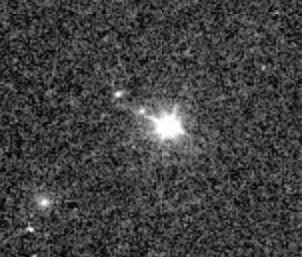 W
W3C 47 is a Seyfert galaxy / lobe-dominated quasar located in the constellation Pisces. It was the first quasar found with the classic double radio-lobe structure.
 W
W3C 66A is a blazar located in the constellation Andromeda.
 W
W3C 371 is a BL Lac object located in the constellation Draco. With a redshift of 0.051, this active galaxy is about 730 million light-years away.
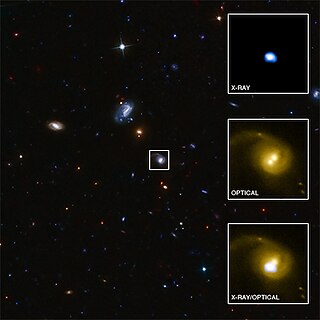 W
WCID-42 is a galaxy quasar about 3.9 billion light years away in the constellation Sextans. It is believed to have a supermassive black hole at its center.
 W
WThe Clowes–Campusano LQG is a large quasar group, consisting of 34 quasars and measures about 2 billion light-years across. It is one of the largest known superstructures in the observable universe. It is located near the larger Huge-LQG. It was discovered by the astronomers Roger Clowes and Luis Campusano in 1991.
 W
WCygnus A (3C 405) is a radio galaxy, and one of the strongest radio sources in the sky. It was discovered by Grote Reber in 1939. In 1951, Cygnus A, along with Cassiopeia A, and Puppis A were the first "radio stars" identified with an optical source. Of these, Cygnus A became the first radio galaxy; the other two being nebulae inside the Milky Way. In 1953 Roger Jennison and M K Das Gupta showed it to be a double source. Like all radio galaxies, it contains an active galactic nucleus. The supermassive black hole at the core has a mass of (2.5±0.7)×109 M☉.
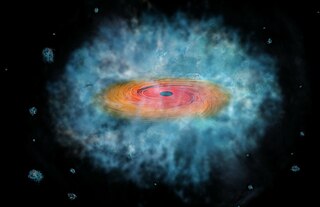 W
WDirect collapse black holes are high-mass black hole seeds, putatively formed within the redshift range , when the Universe was about 100-250 million years old. Unlike seeds formed from the first population of stars (also known as Population III stars), direct collapse black hole seeds are formed by a direct, general relativistic instability. They are very massive, with a typical mass at formation of ~105 M☉. This category of black hole seeds was originally proposed theoretically to alleviate the challenge in building supermassive black holes already at redshift , as numerous observations to date have confirmed.
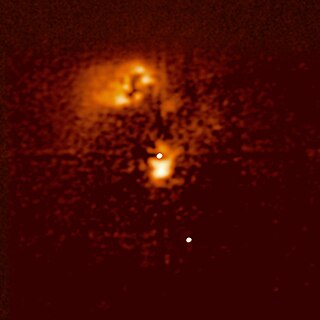 W
WHE0450-2958 is an unusual quasar. It has been called the "naked quasar" and the "quasar without a home" because it appears to lack a host galaxy. It is estimated to lie approximately one billion parsecs away.
 W
WThe Huge Large Quasar Group, is a possible structure or pseudo-structure of 73 quasars, referred to as a large quasar group, that measures about 4 billion light-years across. At its discovery, it was identified as the largest and the most massive known structure in the observable universe, though it has been superseded by the Hercules-Corona Borealis Great Wall at 10 billion light-years. There are also issues about its structure.
 W
WOJ 287 is a BL Lac object located 3.5 billion light-years away that has produced quasi-periodic optical outbursts going back approximately 120 years, as first apparent on photographic plates from 1891. Seen on photographic plates since at least 1887, it was first detected at radio wavelengths during the course of the Ohio Sky Survey. It is a supermassive black hole binary. The intrinsic brightness of the flashes corresponds to over a trillion times the Sun's luminosity, greater than the entire Milky Way galaxy's light output.
 W
WPKS 2000-330 is a quasar located in the constellation Sagittarius. When identified in 1982, it was the most distant and most luminous object known.
 W
WRX J1131-1231 is a distant, supermassive-black-hole-containing quasar located about 6 billion light years from Earth in the constellation Crater.
 W
WS5 0014+81 is a distant, compact, hyperluminous, broad-absorption-line quasar, or blazar, located near the high declination region of the constellation Cepheus, near the North Equatorial Pole.
 W
WSDSS J0927+2943 is an unusual quasar. It exhibits two sets of optical emission lines with different redshifts. The origin of the two emission line systems is believed to be a gravitational wave recoil event: the ejection of a supermassive black hole from the center of the host galaxy. In this interpretation, one of the emission line systems originates in gas that is bound to the black hole, while the other set is associated with gas that remains in the galaxy.
 W
WSDSS J1106+1939 (SDSS J110644.95+193930.6) is a quasar, notable for its energetic matter outflow. It is the record holder for the most powerful matter outflow by a quasar. The engine is a supermassive black hole, pulling in matter at the rate of 400 solar masses per year and ejecting it at the speed of 8,000 km/s. The outflow produce a luminosity of 1046 ergs. This makes the quasar more than two trillion times brighter than the Sun, one of the most luminous quasars on record. The quasar has the visual magnitude of about ~19, despite its extreme distance of 11 billion light years. The outflow of matter from the quasar produces about 1/20 of its luminosity.
 W
WThe Teacup galaxy, also known as the Teacup AGN or SDSS J1430+1339 is a low redshift type 2 quasar, showing extended loop of ionized gas resembling a handle of a teacup, which was discovered by volunteers of the Galaxy Zoo project and labeled as a Voorwerpje.
 W
WTON 618 is a very distant and extremely luminous quasar—technically a hyperluminous, broad-absorption-line, radio-loud quasar—located near the border of the constellations Canes Venatici and Coma Berenices. It possesses one of the most massive black holes ever found, with a mass of 66 billion M☉.
 W
WU1.11 is a large quasar group located in the constellations of Leo and Virgo. It is one of the largest LQG's known, with the estimated maximum diameter of 780 Mpc and contains 38 quasars. It was discovered in 2011 during the course of the Sloan Digital Sky Survey. Until the discovery of the Huge-LQG in November 2012, it was the largest known structure in the universe, beating Clowes–Campusano LQG's 20-year record as largest known structure at the time of its discovery.
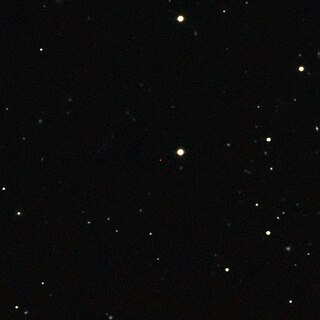 W
WULAS J1120+0641 is the second most distant known quasar as of 6 December 2017, after ULAS J1342+0928. ULAS J1120+0641 was the first quasar discovered beyond a redshift of 7. Its discovery was reported in June 2011.
 W
WULAS J1342+0928 is the most distant known quasar detected and contains the most distant and oldest known supermassive black hole, at a reported redshift of z = 7.54, surpassing the redshift of 7 for the previously known most distant quasar ULAS J1120+0641. The ULAS J1342+0928 quasar is located in the Boötes constellation. The related supermassive black hole is reported to be "800 million times the mass of the Sun".